Martian Sunsets and Submerged Sloths
Why don't we get invisible animals on land? What's at the centre of a gas giant? Did we really land on the moon? Astronomer Matt Bothwell, marine biologist Kate Feller, palaeontologist Jason Head and geneticist Diana Alexander join Chris Smith to shoot the scientific breeze in this month's question and answer spectacular.
In this episode

05:34 - Why do you get transparent animals in the sea but not land?
Why do you get transparent animals in the sea but not land?
Chris Smith put this question to marine biologist Kate Feller...
Kate - There are so many. The majority of invisible animals on the planet are found in what’s called a pelagic zone, or the pelagic animals which means open ocean, open water. It has evolved many many times so you can find worms, crustaceans, jellyfish, fish, so many molluscs. There are certain squid that can make themselves totally transparent. And the reason why there are so many in the ocean and not so much on land - there are a few examples, like there are certain butterflies, these glasswing butterflies have transparent wings. They are absolutely stunning if you’ve never seen one, find one at the Zoology Museum. But the reason that transparency is a lot more difficult on land is because of this thing called refractive indices. Refractive index is just a fancy word to describe the property of light when it enters some sort of material, how it slows down. The refractive index of air is very low, whereas the refractive index of materials like glass - glass is a good one, windows are clear - is very high, so you have a very big difference. And so when you have a very big difference in your refractive index then light is going to bend a lot when it enters that glass. So what happens on a sunny day when you look at a window from the wrong angle? You get a really bright glare, which is not good if you’re trying to be invisible. Water has a much higher refractive index, so does the material that the animals are made of so you can really make that difference in how light moves through the materials very minimal; therefore you can’t see them. Even a piece of glass underwater is very difficult to see because that glare just doesn’t happen.
Chris - So it’s easier for them to become invisible underwater? So, therefore, given that it’s a lot easier to do they’re more likely to do it?
Kate - Correct, yes.
Chris - So some animals do resort to that and it enables them to escape from being eaten?
Kate - Actually, one of my favourite solutions that terrestrial animals have come up with to avoid this anti-glare is a structure called a nipple array.
Chris - Tell us more!
Kate - It’s an array of literally little nipples that will be on the surface of your transparent material. You find this on butterfly wings or moth wings, on a lot of insect corneas so that they don’t give off that glare. Essentially the way that the structure is kind of disrupts the light’s ability to produce glare, and it’s called the nipple array. Let’s have a giggle about that!
Chris - Sounds nearly as good as I heard this week about a beaver deceiver, which is when you want to introduce beavers to an area and you don’t want them to flood the area, you have a way of tapping the water off. But the beavers don’t block it because they don’t know it’s there, but you can nonetheless accommodate the beavers, and have the benefits of the beavers without them actually flooding you out of house and home.
Matt?
Matt - I just wanted to ask about invisible animals. If a marine animal is invisible, that just means the photons are all just passing straight through it. Is it then blind because it can’t capture and of the photons used for vision?
Kate - This is actually what I did my PhD thesis on, or as an aspect of it. A lot of crustacean larvae, for instance, like mantis shrimp larvae, use transparency as a way to disguise themselves in the open ocean because otherwise they’d get eaten very readily. However, they want to see because they’re little predators themselves and, as you were hinting at, you cannot actually see without having some sort of opaque screening pigment within your eye to isolate each photoreceptor from one another because otherwise you’ll muddle all of the pixels of the image that you’re generating. So what they have evolved, a lot of crustacean larvae but I studied the mantis shrimp, is this really beautiful material that I, unfortunately, published under the name of “eyeshine.” I would rather rename it as eye glitter because it is this beautiful blue/green glittery material that is over the surface of this black part of their eye that reflects the wavelength that are behind them perfectly. It is a perfect match and so they have this reflective camouflage strategy to enhance their visibility in the open ocean because you can’t have a truly transparent eye.
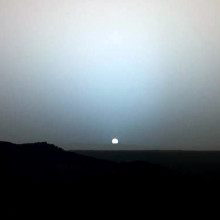
09:58 - What are sunsets on Mars like?
What are sunsets on Mars like?
Chris Smith put Harriet's question to Matt Bothwell, from Cambridge University's Institute of Astronomy, who explained that Martians would enjoy sunsets...
Matt - They do, yes. Sunsets are obviously caused by our Earth is rotating and so, just from our point of view, when our planet swings round we can see the sun again; that’s the sunrise. And Mars is a rotating planet just like Earth so there are sunrises and sunsets on Mars. There a bit strange though because the martian atmosphere is quite different to Earth’s atmosphere. Sunsets on Mars are actually blue rather than the kind of reddy orangey sunsets that we’re used to here on Earth.
Chris - Really! Blue, why are they blue?
Matt - It’s about the composition of the atmosphere. Earth’s atmosphere is gassy and fairly dense, and so when the sunlight passes through Earth’s atmosphere the light is getting scattered by very very small particles. The kind of molecules of nitrogen and oxygen in the air. Mars’s atmosphere is very thin and very dusty, so the scattering is getting done by dust particles instead and they’re much bigger, and so there’s a whole different mechanism that does the scattering. So, in fact, the way dust particles scatter light is that blue light, the short wavelength light, gets scattered forward towards the observer so if you’re watching the sunset on Mars it looks blue.
Chris - Because on Earth, the tiny particles scatter the blue light so your brain is seeing blue coming from all across the sky, so our brain tells us the sky is blue, and the Sun looks a little bit yellower as a consequence. But when the Sun gets down to the horizon on Earth, it does look red presumably because it’s had lots and lots of blue light taken out? So therefore, on Mars, if you’ve got lots and lots of the blue light actually coming straight to you but the red light’s coming out because the big dust is scattering the red it’s going to look bluer, the more atmosphere the light comes through, which is why you’re saying it does look bluer towards the end of the day?
Matt - Yes. It’s also actually a completely different scattering mechanism. On Earth, we have something called Rayleigh scattering which is, just like you say, these short wavelengths get scattered away in all directions. That’s why the sky is blue and the long wavelengths pass straight through so that’s why the Sun is reddy-orange. On Mars, I think it’s something pronounced Mie scattering. That’s a completely different mechanism when you have larger particles and that’s rather than scattering the short wavelengths in all directions like happens in the Earth’s atmosphere, you preferentially scatter the short wavelengths in the direction that the light came from. So you end up with the blue light being boosted away from the Sun…
Chris - Presumably, as it gets towards the horizon, that effect is going to become more and more acute because the path of the light is greater through more of the atmosphere so you’re going to see more of that blue effect?
Matt - Exactly. The Sun in the martian sky looks fairly like the Sun in the Earth’s sky, apart from a bit smaller, but as it gets lower and lower towards the horizon it looks more and more blue.
Chris - Kate?
Kate - Is there a green flash that happens on Mars’ sunset or something with a different wavelength when the last little bit of the ellipse of the Sun passes below the horizon just at that very last moment?
Chris - Have you seen it? Is it real because people refer to it but I’ve never seen it?
Kate - It’s highly debated. I’ve done a lot of research sitting on a beach at sunset, usually with a beer.
Chris - With a tequila or something?
Kate - What we specifically watch it for is the green flash. And the theory behind it seems plausible as far as scatter and everything.
Chris- So, green flash, yes or no on Mars?
Matt - The green flash is absolutely real. I’ve never seen it myself so just in the same way that you’ve been looking for it. I think it’s a bit of a tradition amongst astronomers if you’re observing at an observatory or something to go out at sunset and try and see a green flash. I’ve never been able to see one, but as far as I know there should be a green flash on Mars.
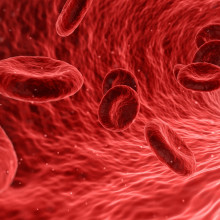
13:26 - Why don't red blood cells have DNA?
Why don't red blood cells have DNA?
Chris Smith put this question to molecular biologist Diana Alexander...
Diana - Yes, it is, exactly. Mature red blood cells have no nucleus which is the compartment that houses the DNA. Immature red blood cells actually do have a nucleus but when they differentiate to become the mature red blood cells the nucleus is actually ejected, so they have no nucleus and no DNA.
As to why this is and how they function, I think the answer is really lies in what they do. Red blood cells, their only real job is to carry oxygen around the body. Not having a nucleus is actually useful for this in terms of they can have more space for hemoglobin, which is the protein which carries oxygen. And also the red blood cells need to be able to squeeze through narrow capillaries, and they have this biconcave disc shape and without a nucleus this is possible.
Chris - This sort of figure eight shape? When you look at them side on they look like a sort of number eight turned on its side don’t they?
Diana - Yeah.
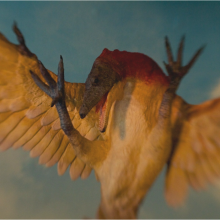
14:24 - Are dinosaurs really birds?
Are dinosaurs really birds?
Chris Smith asked Cambridge University palaeontologist Jason Head if birds really are living dinosaurs...
Jason - Yeah. And the answers absolutely. We know from skeletal anatomy and now we know from preserved soft tissue remains in the fossil record that birds are actually a specialised type of dinosaur; they’re a specialised type of theropod dinosaur. When we actually reconstruct the evolutionary relationships of dinosaurs to include birds, what you see is that all living birds are more closely related to tyrannosaurus rex, or to velociraptor than any of them are to triceratops or stegosaurus, or any of the other dinosaurs that you’ve got in your bag of plastic dinosaur toys as a kid.
So we see this from their skeletal anatomy and now we have from these very fine grain, well preserved environments from the late jurassic on up into the pretentious, evidence of feathers in what you would call non-bird dinosaurs. Now we know, or we have strong hypotheses that feathers initially evolve as both a kind of insulation for being warm blooded, and also as probably communication structures, just like in modern birds.
Chris - It’s amazing we can actually repaint the picture of what these dinosaurs looked like, isn’t it, by studying? There’s enough vestige in the fossils, in the fossil record, in order to create the colour scheme.
Jason - Absolutely! You can actually find in preserved soft tissues the correlates to different kinds of colour cells in modern feathers, and from that we can reconstruct in some of these animals what we think their plumage would have been coloured like.
Chris - Kate?
Kate - Yeah. There also are great fossil examples of structural colours, which is when an animal produces colour not using a pigment. If you grind up the colourful tissue it’s just white.
Chris - Like a butterfly wing is the same thing isn’t it?
Kate - Exactly like a butterfly wing. And so yeah, I just heard about some great research going on studying fossils and what colour they were based on the structures that they find that they have been preserved in, which is wicked.
Jason - There’s one place in Germany called Grube Messel, which is called a lagerstatte which is an area of incredible preservation. It’s an oil shale, and in that oil shale the insects actually preserve their colours - 15 million year old colouring preserved in an insect.
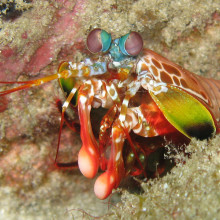
16:54 - How do mantis shrimp punch so fast?
How do mantis shrimp punch so fast?
Cambridge University's Kate Feller took on this marine musing...
Kate - That’s a really good question and actually we don’t know. There are some great biomechanic studying mantis shrimp strikes and their appendages in the States, and they have actually built a model of a mantis shrimp appendage like one of the ones that I have here. The whole thing is exactly the same except for, of course, the material that it’s made out of. They have to try different materials because we only have what humans can make when you make a 3D print or a cast of something. And they found that while they could replicate the actual mechanics of the strike, you end up like when you quickly run your hand through a bucket of water a lot of bubbles will follow your hand from the friction that’s happening - the drag. When you take a video of a mantis shrimp striking underwater, there are no bubbles. It just smoothly goes through the water and the only bubble that forms is this crazy cavitation bubble that is actually a vacuum…
Chris - Which they want?
Kate - Which they want at the point of impact. That’s something that is really cool and would be really nice to know more about.
Chris - Jason?
Jason - I have a more general question: are they prey specific? Are mantis shrimp specialised for a particular type of prey with that strike or are they just opportunists?
Kate - Yes. We generally categorise mantis shrimp into two categories. The spearers, which is like what I have here or in my little shadow box that I brought for ‘show and tell’ Sometimes they’ll have these knarly harpoons...
Chris - Kate’s showing us a bit of a mantis shrimp just for the the jury.
Kate - Yes. I have a shadow box full of weapons - mantis shrimp weapons, and you can see on these larger species they’ve got these huge harpoons, and that’s specialised for stabbing soft bodied prey like fish. And they’ll just stab them and then bring them up to their face and just start eating them whether or not they are dead.
Then the other type of mantis shrimp are what we call the smashers, and these are the ones that are really the world record holders for getting that speed from their strike. The species I have here is an example is super tiny. This is one of those really small species, although these guys can get to be about the 6 inch length size as well. But they have what is essentially on their elbow a big hammer that they will smash hard things with like snails, or crabs, or each other, or rocks.
Chris - So we don’t know. There’s still are a question there about how they manage to move so quickly and not cause these cavitation except where they want it to happen. So there’s important research to be done for you for the next two years Kate. You’ll have to go and find out.
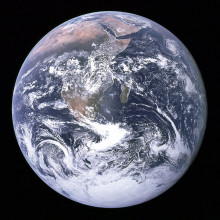
19:39 - How can I prove the Earth is round?
How can I prove the Earth is round?
Chris Smith put Andy's question to Cambridge University astronomer Matt Bothwell...
Matt - Well yeah. So luckily it’s quite easy. We’ve known that the Earth is spherical for thousands and thousands of years. You can do with just observations and common sense really. There are a number of ways to do it; I guess two of the most simple ones. One of them, if you go to a beach - we were talking about looking for the green flash before. Well maybe while you’re looking for the green flash, if you’re sitting on a beach and you watch a ship disappearing over the horizon it doesn’t just fade into nothingness; it will actually dip below the horizon and look like it’s sinking down and that’s because the Earth curves away.
Another one, which is probably my favourite one, is to think about lunar eclipses. A lunar eclipse is when you have the Sun and the Earth and the Moon all in a straight line, and the Moon passes into the Earth’s shadow. The shape of the Earth’s shadow on the Moon is always round; this happens no matter what time the lunar eclipse is occurring. If it was a flat Earth, to get a round shadow, that can only happen at midnight. But you can see lunar eclipses at all different times and the shadow is always round, which means that the Earth has to be spherical.
Chris - So if one looks at the Moon; this is a round shape. If one looks at other planets you see things like moons orbiting other planets; they themselves are round. So there’s lots of evidence that these things tend to be round. The Sun is round so it’s kind of difficult to understand why the Earth wouldn’t be.
Matt - No. I’ve never heard of any flat Mars conspiracy theorists.
Chris - Just flat Earth.
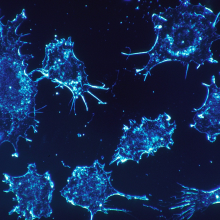
21:09 - Why haven't we evolved a way to defeat cancer?
Why haven't we evolved a way to defeat cancer?
Chris Smith put this question to geneticist Diana Alexander, who started by explaining the process of cancer...
Diana - Cancer is uncontrolled cell division and it leads to the formation of tumours which can cause losses in tissue function, which can eventually result in death, so this is bad for our bodies. So we kind of would expect it to be selected against and, potentially, that we would have evolved not to get cancer, but we still do see people get cancer. I think the answer to this largely lies in how natural selection works to maximise reproduction.
We have evolved ways to prevent cancer at an early age. We have very efficient DNA repair mechanisms which repair DNA damage that can lead to mutations which drive cancer and these work really well. You see cancer occurs at a very low rate in younger people but, in older people, the rate of cancer increases because there are more mutations that accumulate because the repair mechanisms aren’t 100 percent effective.
So the theory is that we haven’t evolved to prevent it completely because we want to maximise reproduction, so you have selection to prevent cancer at a young age. But it’s not selection to prevent cancer indefinitely because the force of natural selection decreases with increased age because there is a lower chance of reproduction. So what we get is kind of a balance where it’s unlikely to get cancer at a young age, but we haven’t evolved to prevent it indefinitely.
Chris - So we’ve evolved not to get cancer up until the time by which we would have reproduced but after that, your body no longer has as much of an ability to select because it won’t harm your ability to pass your genes onto the next generation?
Diana - Exactly.

23:52 - Quiz: Can a sloth or dolphin hold its breath for longer?
Quiz: Can a sloth or dolphin hold its breath for longer?
with Kate Feller, Diana Alexander, Jason Head and Matt Bothwell, Cambridge University
Chris Smith gave the panel a little quiz. Team 1 is Matt Bothwell and Jason Head versus Team 2, Kate Feller and Diana Alexander...
Chris - So team 1: What drug takes the longest to leave the blood, cannabis or alcohol?
You may confer of course.
Matt - I would guess Cannabis.
Jason - I would also guess Cannabis.
[CORRECT sound effect]
Chris - The answer is Cannabis. Cannabis is detectable in the bloodstream for over 300 hours, while alcohol is gone after around 12. However both remain detectable in the hair for around 90 days.
Team 2: This is Kate and Diana.
The longest to degrade in landfill? Rubber Wellington boots or nylon poncho?
Kate - Mmm, rubber boots or nylon poncho? I would say the nylon poncho.
Diana - Yeah, yeah. I would as well.
Kate - Rubber theoretically is kind of natural.
Chris - You’re going for the nylon poncho?
[INCORRECT sound effect]
The rubber boots should take between 50-80 years, while nylon should take around 30-40 years.
Back to team 1, here’s a tough one. What’s going be longer, a barnacle’s penis or the sperm of a fly?
Matt - I remember being told in secondary school that barnacle’s have incredibly long penises and that’s stuck with me for some reason.
Jason - I’m also going to go with the barnacle’s penis.
[INCORRECT sound effect]
Chris - You are being nasty. Kate’s going “yes,yes, yes”. Did you know the answer to that?
Kate - I knew that both were extremely long.
Chris - It will surprise you, I did know the answer to this one because drosophila - Fruit flies have a sperm can be 6cm (only 3mm themselves – equivalent of human having sperm as long as three London busses). Barnacles, for their size, have the largest penis to body ratio, but as they’re extremely small to begin with, an average size is just under a cm.
Chris - Team 2. This is back to Kate and Diana.
What goes the longest without sleep? Walruses or killer whales?
That’s a marine one for you. You should be able to get that.
Kate - Most marine mammals do a really cool thing where they put half their brain to sleep but they’re still technically kind of awake.
Diane - I feel like killer whales.
Kate - I think the whale.
[CORRECT sound effect]
Chris - So we’re level pegging now.
Killer whales! Walrus have been observed staying active for 84 hours without getting any of the usual sleep deprivation problems. But killer whales are well known to be able to go into a semi- sleep, so they can keep swimming, AND, when they’re born, calves and their mothers go for weeks without even this much! The longest a human has stayed awake is around 11 days, but after 3 or 4 severe cognitive problems start to manifest.
Randy Gardner set that record. I think he probably did feel pretty rough but he did perform quite well. He did a press conference at the end of it and they say he answered the questions rather well. But the then slept for about 14 hours the first day and about 10 hours the next day. He did do sort of sleep catch up. You do get symptoms though, not to be advised!
Chris - Team 1 - What can hold its breath for longest? Dolphins or sloths?
Jason - I feel like this is a trick question.
Matt - I feel like the obvious answer is dolphins which makes me want to say sloths.
Jason - I could be persnickety and ask for a species level distinction on the dolphins, but I’m going to fall for trick and I’m going to say dolphins myself.
Chris - What do you think Matt, are you dolphin?
Matt - Yeah. I’ll say the simple answer and say dolphins.
[INCORRECT sound effect]
Chris - Amazingly, sloths can hold their breath for over 20 minutes – some have even reported up to 40, by slowing their heart rate and they’re really good swimmers I was amazed to learn. Dolphins on the other hand can usually only manage around 10 minutes underwater. So the sloths have it.
Chris - Look - you're in with a chance here Team 2.
Which journey would take the longest? From Saturn to the moon Titan, or from centre of the Sun to its surface?
Kate - Where’s my coin. I need to flip it.
Diane - I feel like Sun to surface.
Kate - Yeah, sure. Why not. It’s pretty big.
[INCORRECT sound effect]
Chris - It would be take longer to get to Titan from Saturn than it would to escape the Sun, ignoring the effects of gravity and being burnt into oblivion in the centre of the Sun. Saturn to Titan is over a million kilometres, and the Sun’s radius is just under 700 000.
So you didn’t quite clinch it. So you'll have to leave with your reputation in tatters I’m afraid.
Kate - Yeah. Not my reputation in tact of always losing.
Chris - Yeah that’s true. You’re consistent if nothing else.
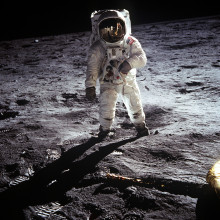
28:57 - Did we really land on the moon?
Did we really land on the moon?
Chris put Peter's query to astronomer Matt Bothwell...
Matt - It’s definitely fact, I’m afraid. We did go back to the Moon a few times. There was the whole Apollo programme which sent several people to the moon. It definitely did happen. I think the reason we didn’t go back is because the reason we went to the Moon in the first place was because of this cold war space race - that kind of ended. I think we realised fairly early on that we can do as much with robots, and it’s much cheaper and much safer than sending people so that’s why we don’t tend to send humans into space so much anymore.
We can know for certain we went to the moon because we have artifacts on the moon. We left a big reflective mirror on there which we can bounce lasers off to measure the distance of the moon.
Chris - People are doing that every day aren’t they?
Matt - That’s right, yes.
Chris - There’s a laser beam that pings off that mirror and that’s how we know the moon is moving what, 2cms further from the Earth every year, give or take?
Matt - Something like that. Yeah, that’s right. We left things on the moon when we went there so yes, we can be very certain that we went.
Chris - Also there was a mission in 2003 which was called Smart One, which was the first example of an ion drive engine driven craft which took lots of pictures of the moon. And they finished the mission by flying over a lot of those landing sites and took pictures of all of the bits and bobs that the astronauts left up there. So we do actually have visual data independently gathered as well. So yeah, I’d say it’s a pretty convincing case, isn’t it that we don’t think it was faked?
Matt - Yes. I’m very happy it wasn’t faked.

30:46 - Are there still dinosaur sized animals?
Are there still dinosaur sized animals?
Chris Smith put this to palaeontologist Jason Head...
Jason - Well, we do. We have animals alive today that are larger in terms of their body mass than any of the dinosaurs but they live in completely different environments. Dinosaurs are exclusively terrestrial in their fossil record I should say. So the largest terrestrial dinosaurs are a group called Sauropods. These are again, to go back to your bag of plastic dinosaur toys, these are the ones with the long necks and these animals include some absolute giants.
There’s a group called Titanosaurs, and several members of that clade may have exceeded 60 to 70 tonnes possibly, but the largest Baleen Whales today still exceed them in overall body mass. They are marine animals where you effectively have no weight in water. Nothing on land today approaches dinosaurs in their size and, in part, that’s because the anatomical physiology of dinosaurs compared to mammals.
Birds are effectively hollow boned dinosaurs whose lungs invade their skeletal tissues. They’re extremely light and it’s very likely they inherited that from dinosaurs that had evolved those strategies initially to achieve large body size.
Chris - When you say their lungs invade their skeleton, what do you man?
Jason - Birds have actually very neumitised vertebral columns, and they’re sacks of the lungs that occupy the spaces within the vertebrae. And so it’s part of this very complex flow through lung that birds have where respiration in a bird doesn’t actually have a dead phase. So, every time you inhale, as a mammal you get this good oxygen and every time you exhale, all you’re doing is getting rid of carbon dioxide. With the very complex lung system that birds have, they’re constantly moving oxygenated blood across their tissues to exchange gas, so they never have one of these dead phases where there’s no oxygen going to the bloodstream.
Chris - And that, obviously, enables them to be very active and to fly very fast and they’re not compromised, and it means they’re lighter?
Jason - Exactly.
Chris - So what’s the relevance to a dinosaur then of that?
Jason - This may very well have initially evolved as an adaptation for being large, so to be a fairly large, initially bipedal animal. The earliest dinosaurs were fairly small but they were bipeds bigger than most birds are today. And so you had to deal with issues of body mass, and one of the ways to lighten the load is to have hollow bones and to have the very efficient respiratory system.
Chris - Interesting theory, but don’t you end up needing bones that are really really strong to hold up a really big mass. Because I remember, I went on a safari in Africa about 20 years ago. I was in Zimbabwe and I found an elephant's leg bone. When you looked at it in cross section, unlike a bone you’d get in a butcher from a cow or something, which would have a very clear marrow cavity where the bone is quite different, it’s spongy in appearance, and that's where all the stem cells that make all your new blood are, in the elephant bone it was almost like solid rock right the way from the outside, the cortex, right the way to the centre. And I asked the safari guy why is it like that? And he said well, elephants make most of their blood in their pelvises and they actually have legs that are solid like tree trunks because they’re supporting 6 to 8 tons, and if they didn’t have that their bones would bend. So what does a dinosaur do then?
Jason - The largest dinosaurs had very massive elephant-like columnar legs. The arms and the legs are the weight supporting bones are incredibly dense, but the vertebral column is actually incredibly delicate. Especially in these giant Sauropods, the vertebrae are almost just a series of struts. They’re very very pneumatic, they’re very light, and they’re very specialised for basically resisting torsion, resisting forces while not being massive and dense.
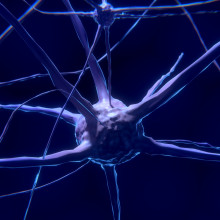
34:24 - How do cells know what to grow into?
How do cells know what to grow into?
Chris Smith put this question to molecular biologist Diana Alexander from Cambridge Universty...
Diana - Exactly. All of the cells in our body pretty much have the same DNA, so the same chromosomes with the same sequences. But the reason why cells are different is because they have different genes that are expressed. So to kind of explain gene expression: if you imagine the genome as a big book with recipes for proteins, gene expression is where some of those recipes are copied into RNA, which is kind of like copies of pages of a book and those are used directly to produce the proteins. So different cell types have different compliments of proteins that are expressed and these determine their functions. For a retinal cell, you’d get production of photoreceptors so that gene for the photoreceptor is expressed. So what underlies these differences in gene expression is epigenetic mechanisms and those are the kind of mechanisms that regulate which genes are expressed by determining which of the pages in the book of the genome are used to make proteins.
Chris - I get it. So can I summarise then saying every cell in the body’s got a copy of the recipe book, but different cells in different tissues achieve their specialisation just by playing out or making some of those recipes but not all of them. So a brain cell is playing out a brain cell specific recipe of genes, whilst a hand sort of muscle cell, is expressing hand muscle genes and a skin cell knows it’s a skin cell. I suppose the key question is also how do those cells know to do that in the first place?
Diana - During the process of differentiation, which is cell specialisation, these epigenetic mechanisms are laid down and put in place. So transcription factors, which are these proteins that determine which genes are expressed will lay down these epigenetic marks and that will determine which genes will be expressed later on in the final form of the cell after it’s differentiated.

36:29 - What's at the centre of a gas giant?
What's at the centre of a gas giant?
Chris Smith put this question to Cambridge University astronomer Matt Bothwell...
Matt - A gas giant is a big gassy planet. If you think of something like Jupiter or Saturn, so instead of what we call the terrestrial or rocky planets like Earth, they’re much bigger and they're not rocky, they’re gassy. The centre of them - they’re not 100% gas. They do have various weird and wonderful things in their centre. If you imagine falling down into Jupiter, the outside is mostly gas and that’s the outer cloud layer that we see.
Chris - What gas is it?
Matt - It’s mostly hydrogen in Jupiter. And then, as you descend into the planet, things get quite strange and the pressure goes higher and higher, and the temperature goes higher and higher and then, eventually, the hydrogen gets pressed into something called a Supercritical fluid. It’s a weird and wonderful state of matter that we don’t really have on Earth because you need very very high pressures.
Below that, the hydrogen is compressed even more into a state of matter called Metallic Hydrogen, so it’s hydrogen that’s been squashed so hard it basically becomes a metal. And that’s how you get massive magnetic fields flowing through there so that’s why Jupiter is like a big magnet in the sky, it’s because of all this metallic hydrogen in it.
And then, at the very centre, there is a solid core. At the very centre of Jupiter there will be a kind of rocky, icy core at the middle and we’ve been able to study that just gravitationally. So when we send missions to Jupiter, we look at the moons orbiting the planet and we study the gravitational interaction and that lets us make a very accurate map of Jupiter’s gravitational field that can only be explained by having a solid core in the centre.
Jason - Can I ask, do we know what the mineral composition of the core is, or is there a decent hypothesis for it?
Matt - I think the answer is no, we really don’t know to be honest. We know it has to be there gravitationally. We have theories based on how planets form so we expect it to be kind of rocky, icy. About 4½ billion years ago during the formation of the solar system there were lots of these rocky, icy planetesimals, and one of these probably acted like a seed, if you like. And then it was far enough out in the solar system, this rocky, icy planetesimal managed to accrete lots and lots of gas and grow very very large. So we think we understand how the solar system was formed reasonably well but yes, it’s not been directly confirmed.

38:42 - How do deep sea creatures know the time?
How do deep sea creatures know the time?
Marine biologist Kate Feller took on this question from Laura...
Kate - Biological clocks are so important to biology and it doesn’t matter if you live with or without light even though the primary genes that regulate circadian rhythms, as we call them, are light sensitive so they typically are regulated by light.
However, there are other cues that animals, for instance, in the deep sea can use in order to have some sort of cycle in their biological activity or just their physiology. And one of those is the activity of everyone living above them in the parts of the ocean that do receive light imput, what they’re doing. So every day, in all of the bodies of water in the ocean that have little tiny critters living in them, there is a mass migration that happens where they go to the surface at night to feed and then they come down to the darker depths during the day so that they can avoid being eaten by things at sea. It’s called the diurnal vertical migration.
When that happens, that activity of going up to eat and then going back down, when you got up to eat and you start eating you then start pooping, and so there are these kind of pulses in nutrients that can happen. You can also have seasonal variation in the amount of nutrients that are falling down just from phytoplankton blooms. So all of the plant type or all of the photosynthetic life that’s living in the ocean, it will change based on the season, and so that is another cue that you can use as a clock.
Chris - Right. So things that are sensitive to sunlight change their behaviour and this has like a domino effect where the repercussions of their activity changing ripple down in the water column to the dark depths where other creatures are then having their body clocks entrained by their stomachs effectively?
Kate - It’s literally all of the nutrients in the deep sea are coming from the surface from the things living above them.

40:57 - What was the first dinosaur discovered?
What was the first dinosaur discovered?
Chris Smith put this question to Jason Head from Cambridge University...
Jason - The first dinosaurs found probably are the mythological origins of griffins. And so it is thought that actually the fossils of a particular dinosaur Protoceratops andrewsi from Mongolia, which has kind of an almost bird-like face, was thought to be the original kind of impetus for that myth.
In the 1670s, there was a fossil described from the UK that was the lower half of a femur of probably a Sauropod dinosaur. It was not recognised as being a dinosaur, it was thought to be a giant. And, in fact, in 1768 right after Linnaeus had established binomial nomenclature, coming up with the genus and the species name because this bone actually had two rounded edges to it it was given the binomial name Scrotum humanum, for exactly why you would think.
Chris - Indeed, yeah.
Jason - The first dinosaur names that actually stick are Megalosaurus, and Iguanodon, and Halosaurus which are based on fossils from the United Kingdom that were discovered around the 1820s.
Chris - And is that when people first became comfortable with the concept of a dinosaur? When did people begin to realise that there was this very long evolutionary timeline on Earth going back millions and millions and millions of years, and that these were clearly antecedents of the life we see on earth today?
Jason - That’s by, I think, about the early 1700s people start to realise that actually there is life preserved through deep time. And the fossil record, the connectivity of it through time is not recognised until much much later.
Chris - Because people didn’t know how old the Earth was at that time, did they?
Jason - That’s exactly right.
Chris - They had no idea the Earth was 4,500 million years old until relatively recently so they had no idea how quick these things had evolved or how long they hadn’t been here for?
Jason - The recognition of superposition of layers of rock does kind of informally come in fairly early, but recognising that what we’re looking at is a succession of related organisms is much later. So dinosaurs, that construct is really Richard Owen in 1842 when he puts the name to the group formally, and is recognised as being this particular group of extinct giant reptiles.
Chris - And what about the meat eating question: how do we know when they tuck into a burger versus prefer to eat grass?
Jason - The shape of their teeth is an excellent indicator of diet. Just like you can look at the teeth in our own mouths and watch their functions, or look at the teeth of a cat or a dog and see how they can slice meat or grind food, the teeth of dinosaurs had the same thing. Meat eating dinosaurs had almost steak knife-like teeth running along the mouths. Herbivorous dinosaurs have evolved these numerous strategies for complex grinding of food akin to what we would see in ruminant mammals today.
Chris - Matt, you were going to say something…
Matt - Yeah, just going to come in on the age of the Earth thing. This is quite an interesting bit from astronomy from that point of view. The age of the Earth also has to be the age of the Sun as well and for a long time we didn’t know how old the Sun was because we didn’t know what powered it, so before we understood stellar nucleosynthesis like the process that’s powering the Sun right now. Our best guess, it was powered by some kind of gravitation and if the sun is powered gravitationally, it can only be about 15 million year old. So, in the late 19th century, some pre-eminent physicists, particularly Lord Kelvin, one of the most famous physicists of his day used this fact to argue against Darwin right. He said the Earth and the Sun can only be about 15 million years old because that’s how old the Sun has to be.
Chris - What changed his mind?
Matt - I’m not sure if his mind was ever changed actually. I think the scientific community’s mind was changed because we came to understand stellar nucleosynthesis, this process that can power stars for billions and billions of years.
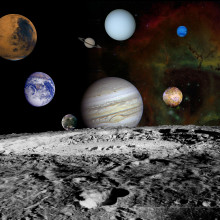
44:37 - What makes something a planet?
What makes something a planet?
Chris Smith put this question to astronomer Matt Bothwell...
Matt - There’s basically three rules, there’s three things you have to fulfil in order to be a planet. You have to be something orbiting a star. You have to be big enough to be spherical so you’ve got to have enough mass that gravity can pull you into a sphere, and you’ve got to have cleared your orbit of debris. And so that third one is the slightly tricky one that tripped Pluto up.
Orbiting a star is kind of obvious, you’ve just gotta be gravitationally orbiting a star. Being spherical: it means about being big enough. If you don’t have enough mass you can be a slightly strange shape. Like Mars has two moons called Phobos and Deimos and they’re both quite small, and they’re both a bit peanut shaped because they’re not big enough to be pulled into a sphere.
So you’ve got to be orbiting a star, you’ve got to be big. But you’ve also got to have cleared your orbit of debris which means if you imagine looking at the solar system from above and drawing a circle at the orbit, you have to be the most major thing in that orbit to be classed as a planet.
It was that third definition that was brought in in 2006 that tripped Pluto up because while the eight planets that we know of know are in nice clean orbits around the Sun, Pluto orbits in a very messy outer part of the solar system called the Kuiper Belt, and there’s all kinds of rocks and space junk out there. The definition was almost brought in because, if you come onto the second part of your question because out in the Kuiper Belt there are almost certainly tens of thousands of things, or even hundreds of thousands of things similar to Pluto. So without this third definition, this orbit clearing definition, you can end up with tens of thousands of planets in the solar system which is just going to be kind of exhausting. So we say that all of these things in the messy part of the solar system are dwarf planets, and then all the B8 inner planets are the classical planets.
Chris - Jason?
Jason - I was going to ask on the debris question, does that mean that the boundary of what is a planet is always going to be in relation to the size of the star and the distance from the star? Basically, if gravitational pull is low enough that you’re not clearing out a bunch of this debris does that just mean that if our Sun was bigger that there’d be less debris out at that level and then Pluto would be cleared to be a planet?
Matt - I think the debris isn’t so much a function of the gravitational pull of the star. It’s about the gravitational pull of the planet itself, so the debris is the stuff that’s left over from the formation of the solar system. Like gathering all the matter to itself and growing and, for the eight planets that we care about, like the A classical planets... I’m being very hard on Pluto now aren’t I? For the eight planets of the solar system they have all the matter that was around in their orbit as they were growing they accreted onto themselves. The outskirts of the solar system, the Kuiper Belt where Pluto lives, this is almost where planet formation didn’t fully complete if you like. So there’s a lot of this debris left over.
Chris - Quick question then, so I can understand say in the region of Jupiter, its own gravity is pretty powerful, so anything in the environs of the planetas it forms are going to be drawn into it. But what about the things on the opposite side of its orbit? So you know, the other side of the Sun form where Jupiter is, how would that get cleared and become part of Jupiter or wouldn’t it al all?
Matt - Well, you have to think about the early solar system as being a very very messy, chaotic place with all kinds of bodies forming and crashing into each other. And thing form heirarchally, they form bottom up in the solar system so individual molecules of gas and dust in the primordial clouds coalesce together. And then you go from molecules of gas to dust grains, to tiny pebbles, to slightly bigger pebbles, to rocks, to mountains, to planetesimals, to planets. And all the time this process is going on, you have all kinds of jostling and colliding. It’s a very chaotic process and it’s only over billions of years that you end up with just one single planet orbiting at that distance.

48:37 - What really killed the dinosaurs?
What really killed the dinosaurs?
Chris Smith put this to palaeontologist Jason Head...
Jason - There are two answers to that question. The first, of course, is that dinosaurs are doing fine today; there’s about 18,000 species of living birds. But the second half of that question is what happened to dinosaurs that aren’t birds? And the last of the non-bird dinosaurs go extinct around the end of cretaceous, that’s 66½ million years ago. That coincides with very strong geological evidence for an extraterrestrial impact of an asteroid or another form of bolide. It appears to be a fundamental global environmental change that corresponds with a mass extinction event in both terrestrial and marine environments. So for the non-birds, it appears that the very last of them went extinct possibly as a result of this impact.
Chris - Were there not some enormous volcanoes going off at around the same time that were also had the potential to make similar changes to the Earth’s climate and the Earth’s atmosphere?
Jason - Yeah. So the last million or two years of the cretaceous of the mesozoic, there’s what is called flood salts in India, the Deccan Traps which are a kilometre and a half thick sequence of volcanic rock formed from these massive volcanoes, and they absolutely are changing Earth’s atmospheric chemistry during this period of time. They are a big and important component of a changing environment.
Chris - Kate?
Kate - If the crater theory is what happened, and this big catastrophic event is what knocked out all of the giant dinosaurs, do you think that it was required for that sort of geological historical event to happen in order for mammals to become so successful, and ergo humans to have become what we are today?
Jason - We think a lot about that. Whether or not the rise of mammals in the cenozoic is the result of ecological release or the loss of competitive exclusion, and there’s some pretty good evidence that that might be the case. Certainly patterns of body size evolution in mammals show that they get bigger when the dinosaurs are gone. We diversity as a clade within a couple of million years of dinosaurs having gone extinct so I think it’s tricky to pin that down 100 percent, but the evidence looks pretty good for it.

50:56 - Do underwater animals need special protection from the water?
Do underwater animals need special protection from the water?
Chris Smith put this to marine biologist Kate Feller...
Kate - Well, fish are not made of iron so they don’t rust as metal would corrode. However, most creatures have some sort of mechanism for turning over the external surface of their body in order to cope with harsh environment which you live in, including humans. We shed skin cells that turn into dust that we have to dust from our homes.
Chris - There’s 40,000 skin cells a second apparently.
Kate - Yeah, tons. So we have mechanisms…
Chris - Fish do the same thing?
Kate - Yeah. So fish will shed skin cells. Crustaceans and arthropods actually they go through more dramatic changes. They’ll go through what’s called the molt, where they literally gro a new exoskeleton and just pop out of the old one. So a soft shell crab is when you’re harvesting crabs that are at that in between phase where they’ve just popped out of the old exoskeleton and they haven’t hardened up into their new one. They basically will grow a new one and there’ll be a soft leathery surface that they’re very vulnerable until it has a chance to deposit the hard materials that make it that hard crab surface.
Chris - But that’s literally just replacing your surface, but what about suppressing things like microbes because they grow really well in wet, damp, gooey places? So these animals are continuously in contact with a damp environment that’s bringing things in that could infect them, so do they have other adaptations to fend that off?
Kate - Yeah. A lot of aquatic creatures will have a mucus layer over the surface of their body. Mantis shrimp actually are super slimy and sometimes in my experiments I need to glue something to them and it doesn’t work very well because it just comes off. They’re just so covered in this layer of slime that presumably has mechanisms of defence against microbes and infection, much like we have mechanisms of defence against that.
Related Content
- Previous Where is Earth's Freshwater Going?
- Next Sampling An Asteroid










Comments
Add a comment